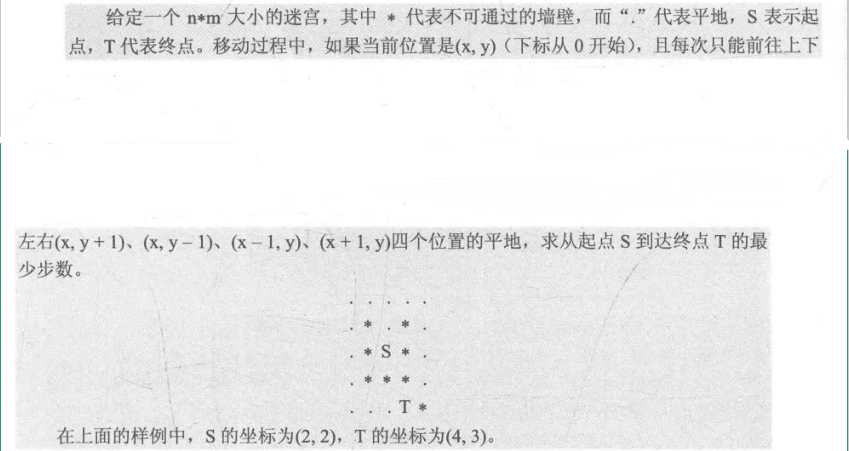广度优先搜索(BFS)
Posted bijian
tags:
篇首语:本文由小常识网(cha138.com)小编为大家整理,主要介绍了广度优先搜索(BFS)相关的知识,希望对你有一定的参考价值。
一、问题:

输入:
6 7
0 1 1 1 0 0 1
0 0 1 0 0 0 0
0 0 0 0 1 0 0
0 0 0 1 1 1 0
1 1 1 0 1 0 0
1 1 1 1 0 0 0
输出:
4
代码:
#include<iostream> #include<algorithm> #include<queue> #include<cstdio> #include<cstdlib> using namespace std; struct node{ int x,y; }Node; void BFSNUM(int x,int y); bool judge(int x,int y); int temp[100][100]; bool inq[100][100] = {false}; int X[4]={0,0,1,-1}; int Y[4]={1,-1,0,0}; int n,m; int main(){ cin>>n>>m; for(int i=0;i<n;i++){ for(int j=0;j<m;j++){ cin>>temp[i][j]; } } int num=0; for(int i=0;i<n;i++){ for(int j=0;j<m;j++){ if(temp[i][j]==1&&inq[i][j]==false){ num++; BFSNUM(i,j); } } } cout<<num<<endl; return 0; } void BFSNUM(int x,int y){ queue<node> q; Node.x = x,Node.y = y; q.push(Node); inq[x][y] = true; while(!q.empty()){ node top = q.front(); q.pop(); for(int i=0;i<4;i++){ int newX = top.x+X[i]; int newY = top.y+Y[i]; if(judge(newX,newY)){ Node.x=newX,Node.y=newY; q.push(Node); inq[newX][newY] = true; } } } } bool judge(int x,int y){ if(x>n||x<0||y>m||y<0){ return false; } if(temp[x][y]!=1||inq[x][y]==true){ return false; } return true; }
二、问题:

输入:
5 5
. . . . .
. * . * .
. * S * .
. * * * .
. . . T *
2 2 4 3
输出:
11
代码:
#include<iostream> #include<algorithm> #include<queue> #include<cstdio> #include<cstdlib> #include<cstring> using namespace std; struct node{ int x,y; int step; }S,T,Node; void BFSNUM(); bool judge(int x,int y); char temp[100][100]; bool inq[100][100] = {false}; int X[4]={0,0,1,-1}; int Y[4]={1,-1,0,0}; int n,m; int main(){ cin>>n>>m; for(int i=0;i<n;i++){ for(int j=0;j<m;j++){ cin>>temp[i][j]; } } cin>>S.x>>S.y>>T.x>>T.y; S.step = 0; BFSNUM(); return 0; } void BFSNUM(){ queue<node> q; q.push(S); while(!q.empty()){ node top = q.front(); q.pop(); if(top.x==T.x&&top.y==T.y){ cout<<top.step<<endl; } for(int i=0;i<4;i++){ int newX = top.x+X[i]; int newY = top.y+Y[i]; if(judge(newX,newY)){ Node.x = newX,Node.y=newY; Node.step = top.step+1; q.push(Node); inq[newX][newY] = true; } } } } bool judge(int x,int y){ if(x>n||x<0||y>m||y<0){ return false; } if(temp[x][y]==‘*‘||inq[x][y]==true){ return false; } return true; }
三、问题:马的移动
题目描述
小明很喜欢下国际象棋,一天,他拿着国际象棋中的“马”时突然想到一个问题:
给定两个棋盘上的方格a和b,马从a跳到b最少需要多少步?
现请你编程解决这个问题。
提示:国际象棋棋盘为8格*8格,马的走子规则为,每步棋先横走或直走一格,然后再往外斜走一格。
给定两个棋盘上的方格a和b,马从a跳到b最少需要多少步?
现请你编程解决这个问题。
提示:国际象棋棋盘为8格*8格,马的走子规则为,每步棋先横走或直走一格,然后再往外斜走一格。
输入
输入包含多组测试数据。每组输入由两个方格组成,每个方格包含一个小写字母(a~h),表示棋盘的列号,和一个整数(1~8),表示棋盘的行号。
输出
对于每组输入,输出一行“To get from xx to yy takes n knight moves.”。
样例输入 Copy
e2 e4
a1 b2
b2 c3
a1 h8
a1 h7
h8 a1
b1 c3
f6 f6
样例输出 Copy
To get from e2 to e4 takes 2 knight moves.
To get from a1 to b2 takes 4 knight moves.
To get from b2 to c3 takes 2 knight moves.
To get from a1 to h8 takes 6 knight moves.
To get from a1 to h7 takes 5 knight moves.
To get from h8 to a1 takes 6 knight moves.
To get from b1 to c3 takes 1 knight moves.
To get from f6 to f6 takes 0 knight moves.
代码:
#include <cstdio> #include <iostream> #include <cstring> #include <algorithm> #include <queue> using namespace std; //每步棋先横走或直走一格,然后再往外斜走一格。 struct node{ int x,y,step; }; void BFS(); bool judge(int x,int y); int temp[8][8]; bool inq[8][8]; int to[8][2]={-1,-2,-2,-1,-2,1,-1,2,1,2,2,1,2,-1,1,-2}; int sx,sy,ex,ey,ans; int main(){ char c1[10],c2[10]; while(cin>>c1>>c2){ sx = c1[0]-‘a‘; sy = c1[1]-‘1‘; ex = c2[0]-‘a‘; ey = c2[1]-‘1‘; BFS(); printf("To get from %s to %s takes %d knight moves. ",c1,c2,ans); } return 0; } void BFS(){ for(int i=0;i<8;i++){ for(int j=0;j<8;j++){ temp[i][j]=0; inq[i][j]=false; } } node S; S.x = sx; S.y = sy; S.step=0; queue<node> q; q.push(S); inq[sx][sy] = true; while(!q.empty()){ node v = q.front(); q.pop(); if(v.x == ex&&v.y == ey){ ans = v.step; } for(int i=0;i<8;i++){ int newX = v.x +to[i][0]; int newY = v.y +to[i][1]; if(judge(newX,newY)){ node newnode; newnode.x = newX; newnode.y = newY; newnode.step = v.step+1; q.push(newnode); inq[newX][newY] = true; } } } } bool judge(int x,int y){ if(x<0||x>=8||y<0||y>=8||inq[x][y]==true){ return false; } return true; }
以上是关于广度优先搜索(BFS)的主要内容,如果未能解决你的问题,请参考以下文章